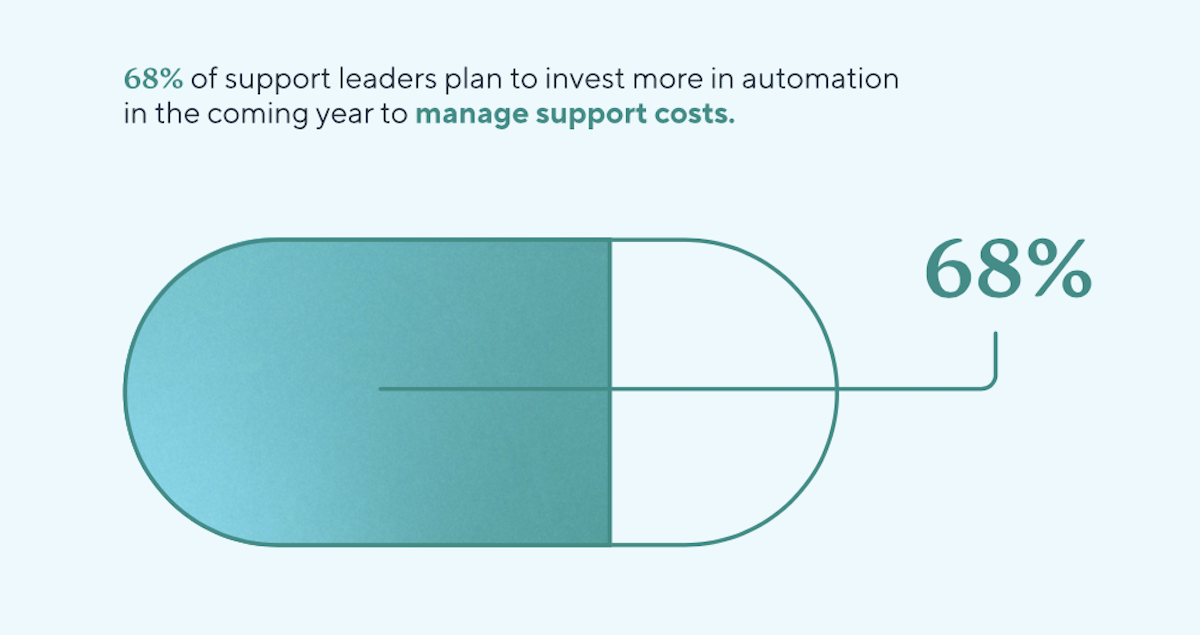5 ways to bridge the customer service expectation gap in 2024
As technology advances and customers’ options expand, customer service expectations are skyrocketing.
The customer expectation gap has been widely reported on in the years since the pandemic (not least by us last year!), and our latest Intercom Customer Service Trends Report for 2023 shows that expectations are now higher than ever. There’s a new bar for what’s possible, and word of mouth now spreads on a global scale.
This year, a whopping 83% of support teams are seeing customer expectations increase, up from 75% the previous year. When it comes to support, its availability, and the quality of the customer experience, there’s no longer any room for mistakes.
“Businesses that act fast can get ahead of their customers’ expectations”
The good news? Heading into 2023, more teams are prepared to meet these expectations, with 40% saying they’re confident they can measure up – versus 34% in 2021. Businesses that act fast can get ahead of their customers’ expectations and begin to close the gap. Here are five things you can do to get ahead.
1. Leverage first-party data for a truly personal touch
When it comes to meeting rising customer expectations, personalization is a must. In fact, 89% of support leaders cite personalization as a key competitive differentiator, and teams that offer personalized service are almost twice as likely to report higher customer satisfaction scores, retention, and loyalty.
“82% of support leaders say that customer expectations for personalized support have increased over the last 12 months”
And demand is only increasing – 82% of support leaders say that customer expectations for personalized support have increased over the last 12 months, however, 54% lack the tools they need to achieve the level of personalization their customers expect, at scale.
So how can teams start to close the customer expectation gap when it comes to personalization? As counter-intuitive as it may seem, automation can help you take a more personal approach with your customers. By folding automation into your personalization strategy, you can collect first-party data more effectively and offer every customer a personal service when they need it, where they need it.
 |
“We want to make sure that each customer’s experience is tailored to the needs of that particular customer, because we’ve seen that personalized experiences drive much stronger outcomes than non-personalized experiences.” – Craig Vincent, Head of Global Success Programs, Customer Success, at Amplitude |
First-party data is information you’ve collected first-hand – from sources like sign-up forms, and actions taken in your product or app. Because it’s coming directly from your customers, it’s more reliable, effective, and useful. Many customers are happy to share their data with businesses in return for a more personal, engaging experience, and support tools, like chatbots, can help you to automatically gather rich context about each customer, such as their plan, transaction history, or previous queries.
But first-party data isn’t just about who your customers are, it’s about what they do. By setting up personalized flows that activate in-product messaging based on customer behavior, you can help your customers right where they are and anticipate their needs.
In-product messaging is in-context, convenient, and helps customers in the moment, saving them from switching channels or devices to get the help they need. Not only that, you can use it to guide your customer through your product, encouraging them to take the steps they need to succeed, and catering to their unique goals with a personalized product journey. Having this first-party data at your fingertips will help you and your team nail personalization and, ultimately, retain happy customers!
2. Empower your customers to self-serve
It’s an uncertain time for businesses in every industry, and support teams are having to find ways to do more with less.
Every time a customer chooses to self-serve, your team is freed up to answer more complex queries – offering a better experience to your customers, reducing response times, and easing the burden on your support reps. Luckily, customers are more than happy to self-serve – in fact, study after study indicates customers would rather self-serve than talk to a support rep at all. A survey we conducted at the end of 2022 revealed that nearly four in five respondents believe there are even circumstances where chatbots and online chat are preferable to any other form of communication from a business.
“68% of support teams plan to invest more in automation to manage support costs in 2023”
It’s no wonder, then, that 77% of support teams plan to invest more in self-serve support, like knowledge base articles and FAQs, to increase efficiency in 2023. Preparing an adequate knowledge base, help center, or blog with a clear navigation path is vital for customer empowerment. Using a modern support tool like a messenger, you can present these options at the “Chat with us” stage, helping users narrow down and simplify their search.
To free up even more time for your support reps and reduce response times for your customers, why not automate responses to the most common FAQs, and proactively offer helpful resources to reduce inbound conversation volume? We recommend planning out the different types of content customers need at each stage of their journey so you can anticipate their queries. For example:
- Getting started guides for the beginner.
- FAQs and how-to articles for the novice.
- Best practice guides and troubleshooting articles for the proficient.
With the arrival of ChatGPT, it seems likely that self-serve support will become easier, and more popular, than ever. By investing in a strong automation strategy now to help empower your customers to self-serve, you could save an abundance of time – and money – in the long run. And it’s not just us who think so – 68% of support teams plan to invest more in automation to manage support costs in 2023.

3. Aim for optimal response time
While, in the past, the term “automation” has denoted anything but personalization, its impact on customer experience has changed how customers view it: less as a nuisance, and more as a legitimate personalized option for getting assistance. Your customers’ time is as valuable as their money, so delivering the answers they need as quickly as possible is vital to meeting their expectations. Setting up automation to handle frequent queries respects your customers’ time, reduces inbound volume, and helps optimize workflow efficiency.
“Live chat tools like a business messenger can let the customer know when they should expect a reply”
50% of teams are turning to next-generation bots and automated solutions to optimize their workflow efficiency and meet customer expectations. By implementing chatbots, you can triage customer queries to ensure they go to the right team and deliver a resolution as quickly as possible. You can also use them to route urgent or VIP queries to the appropriate inbox, and guarantee the fastest response times where they’re needed most.
Automating elements of your customer support not only allows your team to work faster, it also reduces their workload – and allows you to set customer expectations more effectively. Even if a member of your support team isn’t available immediately, live chat tools like a business messenger can let the customer know when they should expect a reply, provide personal, in-context resolutions to FAQs, or offer help center articles to assist your customer while they wait. This removes some of the uncertainty from the situation and makes them feel valued.
Most customers understand that teams can’t be online 24/7 – after all, no-one would arrive at a physical store at midnight and expect to be served – but it’s important to tell them when their query will be addressed.
4. Measure and optimize for success
Customer service teams often spend their days working across a large number of tools to give their customers the answers they need. When it comes to measuring success, this can leave teams with a disjointed and confusing jumble of results – with no single source of truth to monitor and pull insights from.
Finding comprehensive ways to report on success is a major part of improving workflow efficiency, and ultimately, your customers’ experience. But when gathering metrics takes more time than supporting customers, how do you justify the time investment? Choosing a customer service tool that offers easy-to-read, customizable reporting can save countless hours for your team, and make it all the easier to take strategic, evidence-based decisions that will begin to close the customer expectation gap.
“Almost one-third of support leaders cited ‘limited reporting capabilities’ as a major challenge with their customer service tech stack”
As budgets shrink, teams must ensure that every tool in their tech stack is working hard and providing a clear return on investment – in fact, 73% of support leaders say they’ll need to make their tech stacks more streamlined and cost-effective over the next 12 months. The role of a support rep is so multi-faceted that, for a customer service tool, that means being able to not only enable your support team to offer a world-class customer experience, but also to measure and optimize for success.
In our Customer Service Trends Report for 2023, almost one-third of support leaders cited “limited reporting capabilities” as a major challenge with their customer service tech stack. In-depth reporting can reveal your busiest times and most-used channels – allowing you to resource more effectively and reduce your response time as a result. Over time, you’ll start to notice the effect on your key metrics and costs, and use this data to further improve efficiency and customer experience.
5. Invest in your support team’s morale
It’s been an incredibly challenging year for support teams. From headcount reductions and economic uncertainty, to increasing expectations and new technologies – support teams are having to adapt at breakneck speed.
It’s unsurprising, then, that 51% of support leaders are reporting a drop in team morale – and 44% expect to see a drop in the next 12 months. If the people at the front lines of your business aren’t engaged, your customers will feel it.
“In 2023, 52% of support leaders are maintaining morale by investing in technology that helps with their team’s workload and reduces frustration”
We’ve discussed the effect automation has on maximizing your team’s efficiency, but we recommend exploring your team’s needs a little more closely to really stay on top of morale. In 2023, 52% of support leaders are maintaining morale by investing in technology that helps with their team’s workload and reduces frustration. For example, legacy support channels, such as email and phone, tend to be time-consuming and require a lot of team power. It may be time to reassess the tools your team uses and perhaps ask yourself the following questions:
- Are these tools still relevant to our strategy?
- Could our processes be simplified with integrations?
- What issues are our team currently facing?
- Are there tools available to directly address these issues?
This is a good starting point to empower and upskill your team – aim to minimize any difficulties they may be having and look for ways they can get better satisfaction out of their work.
 |
“The happier our team is, the easier it is for them to delight our customers.” – Geronimo Chala, Chief Consumer Officer, Rebag |
But it is not just the technical side of your team’s work you need to address. Support teams are trying to manage ever-rising queries – many of which may be emotionally charged – and 54% of customer support leaders say members of their teams have felt “burned out” in the past 12 months. Fortunately, this represents a decrease of ten percentage points from last year’s results, but it’s nevertheless a worryingly high number.
The evolving status of the customer service role as a strategic value driver should be recognized in the support, benefits, and development these teams receive. In 2023, 64% of support leaders are allowing flexible working conditions, while 54% are adjusting workloads to make them more manageable and enjoyable. Here at Intercom, we also focus on building a culture around the following people-centric strategies to help our support team go further:
- Mapping out career paths
- Setting goals to properly reflect the work
- Treating humans like humans
- Amplifying your team’s successes
Investing in your support team’s development and wellbeing will result in more motivated individuals who are happy to remain loyal members of your team, and 53% of support leaders claim that their improved ability to meet customer expectations is down to better team training. Whether you’re upskilling your team to use your customer service tool more effectively, or to better support customers with complex queries – offering training is a sure way to build team morale and loyalty.
Keep on raising the bar for customer support
Customer expectations will keep growing as technology develops and economic uncertainty continues. But, getting ahead of the curve doesn’t need to be overly daunting so long as you keep experience front and center – both for your customers and your support team.
However, heightened expectations are just one area of customer support that’s seeing a shift. Engagement, changing customer behavior, and proactive customer service, to name just a few, are major trends that are transforming customer support. Learn how to future-proof the success of your team with The Intercom Customer Support Trends Report for 2023.








